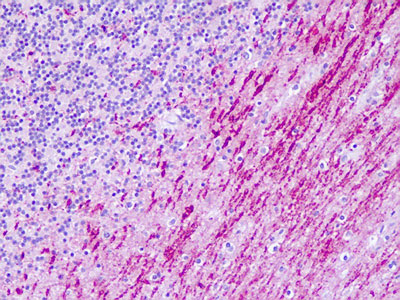HTR6 / 5-HT6 Receptor Antibody (C-Terminus)
Rabbit Polyclonal Antibody
- SPECIFICATION
- CITATIONS
- PROTOCOLS
- BACKGROUND

Application
| IHC-P |
|---|---|
| Primary Accession | P50406 |
| Reactivity | Human, Hamster, Monkey, Horse, Dog |
| Host | Rabbit |
| Clonality | Polyclonal |
| Calculated MW | 47kDa |
| Dilution | IHC-P (10-20 µg/ml) |
| Gene ID | 3362 |
|---|---|
| Other Names | 5-hydroxytryptamine receptor 6, 5-HT-6, 5-HT6, Serotonin receptor 6, HTR6 |
| Target/Specificity | Human HTR6 / 5-HT36. BLAST analysis of the peptide immunogen showed no homology with other human proteins. |
| Reconstitution & Storage | Long term: -70°C; Short term: +4°C |
| Precautions | HTR6 / 5-HT6 Receptor Antibody (C-Terminus) is for research use only and not for use in diagnostic or therapeutic procedures. |
| Name | HTR6 (HGNC:5301) |
|---|---|
| Function | G-protein coupled receptor for 5-hydroxytryptamine (serotonin), a biogenic hormone that functions as a neurotransmitter, a hormone and a mitogen (PubMed:35714614, PubMed:36989299, PubMed:37327704, PubMed:8522988). Also has a high affinity for tricyclic psychotropic drugs (By similarity). Ligand binding causes a conformation change that triggers signaling via guanine nucleotide- binding proteins (G proteins) and modulates the activity of downstream effectors (PubMed:35714614). HTR6 is coupled to G(s) G alpha proteins and mediates activation of adenylate cyclase activity (PubMed:35714614, PubMed:37327704). Controls pyramidal neurons migration during corticogenesis, through the regulation of CDK5 activity (By similarity). Is an activator of mTOR signaling (PubMed:23027611). |
| Cellular Location | Cell membrane; Multi-pass membrane protein |
| Tissue Location | Expressed in several human brain regions, most prominently in the caudate nucleus. |
| Volume | 50 µl |

Thousands of laboratories across the world have published research that depended on the performance of antibodies from Abcepta to advance their research. Check out links to articles that cite our products in major peer-reviewed journals, organized by research category.
info@abcepta.com, and receive a free "I Love Antibodies" mug.
Provided below are standard protocols that you may find useful for product applications.
Background
This is one of the several different receptors for 5- hydroxytryptamine (serotonin), a biogenic hormone that functions as a neurotransmitter, a hormone, and a mitogen. The activity of this receptor is mediated by G proteins that stimulate adenylate cyclase. It has a high affinity for tricyclic psychotropic drugs (By similarity). Controls pyramidal neurons migration during corticogenesis, through the regulation of CDK5 activity (By similarity). Is an activator of TOR signaling (PubMed:23027611).
References
Kohen R.,et al.J. Neurochem. 66:47-56(1996).
Kopatz S.A.,et al.Submitted (OCT-2003) to the EMBL/GenBank/DDBJ databases.
Gregory S.G.,et al.Nature 441:315-321(2006).
Mural R.J.,et al.Submitted (JUL-2005) to the EMBL/GenBank/DDBJ databases.
Ullmer C.,et al.FEBS Lett. 370:215-221(1995).
If you have used an Abcepta product and would like to share how it has performed, please click on the "Submit Review" button and provide the requested information. Our staff will examine and post your review and contact you if needed.
If you have any additional inquiries please email technical services at tech@abcepta.com.













 Foundational characteristics of cancer include proliferation, angiogenesis, migration, evasion of apoptosis, and cellular immortality. Find key markers for these cellular processes and antibodies to detect them.
Foundational characteristics of cancer include proliferation, angiogenesis, migration, evasion of apoptosis, and cellular immortality. Find key markers for these cellular processes and antibodies to detect them. The SUMOplot™ Analysis Program predicts and scores sumoylation sites in your protein. SUMOylation is a post-translational modification involved in various cellular processes, such as nuclear-cytosolic transport, transcriptional regulation, apoptosis, protein stability, response to stress, and progression through the cell cycle.
The SUMOplot™ Analysis Program predicts and scores sumoylation sites in your protein. SUMOylation is a post-translational modification involved in various cellular processes, such as nuclear-cytosolic transport, transcriptional regulation, apoptosis, protein stability, response to stress, and progression through the cell cycle. The Autophagy Receptor Motif Plotter predicts and scores autophagy receptor binding sites in your protein. Identifying proteins connected to this pathway is critical to understanding the role of autophagy in physiological as well as pathological processes such as development, differentiation, neurodegenerative diseases, stress, infection, and cancer.
The Autophagy Receptor Motif Plotter predicts and scores autophagy receptor binding sites in your protein. Identifying proteins connected to this pathway is critical to understanding the role of autophagy in physiological as well as pathological processes such as development, differentiation, neurodegenerative diseases, stress, infection, and cancer.


